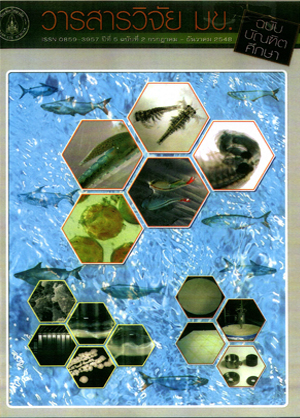Electronic Structures and Adsorption Properties of Bimetallic Sub-Nanoclusters PdAl การศึกษาโครงสร้างทางอิเล็กตรอนแล:ะสมบัติการดูดชันของ PdAly
Keywords:
density functinal calculation, Pd/A1 alloyAbstract
The electronic structures and adsorption properties of Pd-Al bimetallic clusters have been theoretically investigated by using an all-electron scalar relativistic density functional method. The nanoscale Pd , Pd , and Pd clusters with Oh symmetry point group were selected to model Pd-Al bimetallic clusters. The presence of A1 atoms introduced stabilization of bimetallic clusters, the average cohesive energy per atom increased when Pd atoms were replaced by A1 atoms. A1 atoms preferentially occupied surface layer and second sublayer of the clusters to produce well distributed alloy. Stabilization led to downwards movement of total d-band center. The adsorption properties of Pd-Al bimetallic clusters relative to the pure Pd clusters have been studied using carbon monoxide as a probe molecule adsorbed on three-fold hollow sites of the (111) facets. The calculated CO adsorption energies and vibrational CO frequencies demonstrated the weakening of the adsorbate-substrate interactions in the presence
of A1 atoms in the clusters.
ได้สืกษาโครงสร้างทางทฤษฎีของการกระ,จารยซิ1เล็กตรอนและสบปดการ'ดู'ดชับของกลุ่มอะตอบโลหะผสม พัลลาเดียม-อลูมิเนียม ด้วยการคำนวณฟ้งก์,ชันความหนาแน่น,นโ'ดยโฟ้อเล็1กดรอนทงหมด กล่มอะตอมพัลลาเตี ยมทใซ'ชระกอบด้วยอะตอมพลลาเคียม 55 79 และ 116 อะตอม ครงสรางแบบทรงแปดหน้า และได้
สืกษาอะตอมของโลหะผสมที่ถูกสT1งขึ้นโดยการแทรกอะดอ^อมฟ้าแทน^อะตอมฟ้ลลาเสืยมในบาตำแทน่ง ผลการคำนวณพบว่าอสูมิเนียม''หที่ยานำโน้ผส็กบีความเส^ยรมาก[1] [2]น ^ดย^



